Official Name
Oradea in Romanian, Nagyvárad in Hungarian and Grosswardein in German (the latter is just a translation of the Hungarian name). Since Oradea and the area around was Hungarian territory for a long time and many Hungarians still live in the city, you can see the Hungarian name quite often.
Location

| ||
| Oradea |
Oradea, more than 400 km (as the crow flies) north-west of →Bucharest, is only around 10 km away from the border to →Hungary. It marks the northern centre of the historic district Crişana and Banat (Banat is the southern part, Crişana the area around Oradea). The town lies in a fertile plain, which gradually develops into the Puszta in the north and the west. The small river Crişul Repede flows through the centre of town. Oradea is the administrative centre of Bihor district.
Population
About 210,000. Oradea is the 11th largest town in Romania. Every fourth citizen is Hungarian.
Orientation
Oradea belonged to the Austro-Hungarian empire for quite a long time, and this is evident in the old centre of town. Almost all buildings display Habsburg-style architecture, making the town looking completely different to other towns in Romania. The river Repede crosses the town from east to west. There are two squares facing each other at the riverside - one is called Piaţa Ferdinand , the other Piaţa Unirii (Union Square). South of the river and east of a large park, there's the old citadel of Oradea. The train station is about 2 km away from the centre in the northern part of town. Str. Republicii leads to the station. Around 10 km to the north-west there's the border crossing. Several crumbling factories, some new shops, petrol stations and more line up along the road to the crossing.
Getting there / transportation
There are some direct trains from →Budapest to Oradea. However, it's much cheaper to take the local train to Biharkeresztes and then to Püspökladany on the Hungarian side. But only very few local trains cross the border. The only option to get to and from the border crossing is by taxi, which costs around € 10 from the crossing to the centre of Oradea (I guess we've paid too much, but we hadn't had a choice - it was the only taxi).
There are some daily trains to →Satu Mare north-east of Oradea and to →Cluj-Napoca (Klausenburg) in the east. The local train to the latter needs a gruelling 5 hours (for 130 km!) and costs 8.30 Lei (euro; 2) per person. The accelerat needs half of the time for twice the money. There's also a direct train to the capital →Bucharest.
Several thousand years ago, first tribes settled in the area around present-day Oradea. But a town was not mentioned before the year 1113. The place was known as Varadinum (see the Hungarian and German name above!). At that time, the area was part of the Hungarian Kingdom and became an important Catholic stronghold. From 1660 to 1692, Ottomans occupied the town, but the town continued to grow. Since 1692, Oradea was part of the Habsburg-ruled Austrian empire, which shouldn't change until the defeat of Austria in the year 1918. Ever since, Oradea marked the western border of the Romanian kingdom. In 1940, Hungary invaded the town, and so it remained under Hungarian control until 1944. Again it became a part of Romania, with a strong Hungarian minority, which was about to play an important role in the 1989 revolution. At the beginning of the 20th century, Oradea was also called 'Petit Paris'. When you walk around the old town you will understand why.
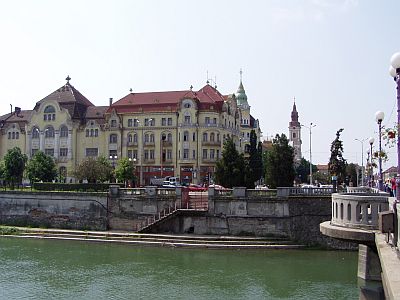
| ||
| View over Crişul Repede to the Hotel Vulturul Negru |
The area around Piaţa Unirii and Piaţa Ferdinand is particularly interesting. The two squares are joined by a bridge spanning the river Repede. Among the buildings facing Piaţa Ferdinand, there's the National theatre and other magnificent buildings.
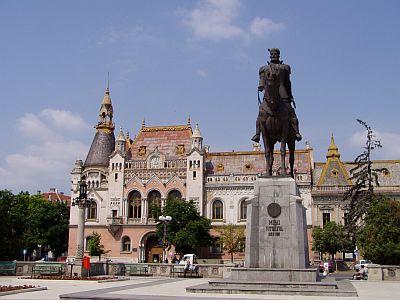
| ||
| Viteazul Statue on Piaţa Unirii |
At Piaţa Unirii, there's the large Hotel Vulturul Negru, which is under reconstruction (as of summer 2004). There's an old and beautiful shopping arcade inside the hotel. Within sight, there's the crumbling synagogue, which doesn't seem to be used at the moment. In the middle of Union Square, there's a statue of Mihail Viteazul - a Wallachian prince from the 16th century. Another highlight at Union Square is the Orthodox Moon Church with a clock adjusted to the moon's orbit, which is quite unusual. Unfortunately it's not possible to see the clockwork. Furthermore, the city hall as well as the library are worth a closer look.
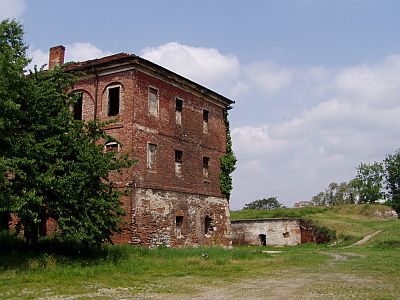
| ||
| The somehow morbidly fascinating citadel of Oradea |
Walk eastwards from Piaţa Unirii for a few minutes and you will get to the Central Park with the Palace of Culture standing in the middle of it. Within spitting distance of the park, there's the large Cetatea Oradiei (Oradea Citadel), which was already built in the 11th and 12th century. The red-brick fortress shows the typical jagged ground plan. It is surrounded by a wide and deep moat and has countless cellars and underground passages. Since the fortress is not restored at all, it's possible to walk around freely and have a closer look at the remainings. A fascinating place. Some of the buildings inside are more or less intact and used by the Academy of Arts, which is obvious when you see all the artworks installed in the courtyard. As of May 2004, parts of the citadel were under reconstruction. However, it's a very large citadel and it will take many years if not decades to accomplish the task.
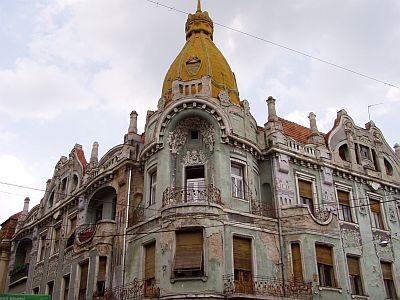
| ||
| Great but dilapidated buildings on Str. Republicii |
The main pedestrian zone in town is called Str. Republicii, starts at Piaţa Ferdinand and runs direction north-east. Many hotels, restaurants, cafés, boutiques etc line up along the street making it a popular shopping street. There are also some magnificent houses built around the year 1900 during Oradea's heyday. Unfortunately, many of the buildings are in a very bad condition, but some of them have been already restored. Especially the buildings around the corner of Str. Republicii and Str. Eminescu are particularly beautiful. If you want to see a well-preserved Habsburg town, Oradea is the place to go. You won't see something similar in Hungary or Austria.
Only a few kilometres south of the town, there are two spas called Băile Felix and Băile 1 Mai. Both of them have several swimming pools and thermal springs. Buses run between the town and the spas.
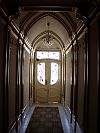
| ||
| Hotel Parc |
There are several inexpensive hotels in the centre - among them Hotel Parc right in the centre on Str. Republicii. A nice and clean double room (shared bathroom) incl. cable TV and breakfast (coffee not included!) cost 81.6 Lei (€ 20) per night. I guess there are some cheaper places, too, but the location and the atmosphere of this time-honoured hotel are just great as you can see on the picture (showing the entrance of the hotel). Address: Str. Republicii 5-7, Tel.: (059)-411-699.
There are several cafés and restaurants in the vicinity of the hotel. Only some metres away from Hotel Parc (walk right when you get out of the hotel) there's a restaurant called Cyano (not sure if the name is correct). Cyano serves good quality Hungarian and Romanian food for around € 2.
- www.oradea.ro Official website of Oradea with summaries in English and French. Worth a look.
- mitglied.lycos.de/mazsola Several pictures of Oradea. The rest is in German.
Do you have or do you know a good website about Oradea? Don't hesitate, let me know! After checking it, I would love to add it to the link list. You can submit a link by using the →contact form. Note that commercial websites will be treated differently.
©2024 Europe-East.com

 Albania
Albania Romania
Romania